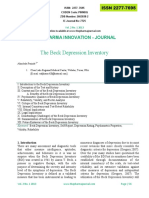0% found this document useful (0 votes)
18 views3 pagesChapter No 3
The study focuses on clinical patients with chronic pain and depression in Pakistan, employing a purposive sampling technique to gather data from 50 participants. Inclusion criteria involve male and female patients with chronic illness, while those with acute illness are excluded. Data collection utilized three instruments: the Beck Scale for Suicide Ideation, the British Pain Rating Scale, and the Beck Depression Inventory, with analysis conducted using correlation and multiple linear regression via IBM SPSS Statistic 21.
Uploaded by
organizationalbehaviors3Copyright
© © All Rights Reserved
We take content rights seriously. If you suspect this is your content, claim it here.
Available Formats
Download as DOCX, PDF, TXT or read online on Scribd
0% found this document useful (0 votes)
18 views3 pagesChapter No 3
The study focuses on clinical patients with chronic pain and depression in Pakistan, employing a purposive sampling technique to gather data from 50 participants. Inclusion criteria involve male and female patients with chronic illness, while those with acute illness are excluded. Data collection utilized three instruments: the Beck Scale for Suicide Ideation, the British Pain Rating Scale, and the Beck Depression Inventory, with analysis conducted using correlation and multiple linear regression via IBM SPSS Statistic 21.
Uploaded by
organizationalbehaviors3Copyright
© © All Rights Reserved
We take content rights seriously. If you suspect this is your content, claim it here.
Available Formats
Download as DOCX, PDF, TXT or read online on Scribd
/ 3






































































































